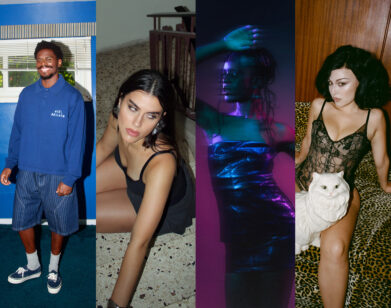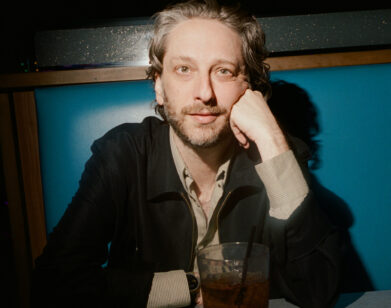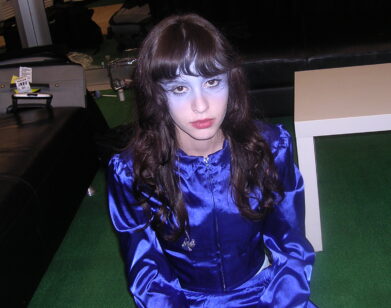Dawn Golden’s Occult Classic

ABOVE: DEXTER TORTORIELLO
While a quick Google search of the phrase returns any number of diverse cultural references, Dexter Tortoriello insists his electronic solo project, Dawn Golden, is a play on the name of an occult organization, the Hermetic Order of the Golden Dawn, and that one of the group’s most famous followers, the late and infamous Aleister Crowley, has held his fascination for many years. Though Tortoriello says he eventually abandoned efforts to integrate elements of the occult into his work, an undeniably mystical quality still permeates his music. Powerful crescendos, brooding minor chord progressions, and syncopated drumbeats are the meat of Tortoriello’s debut LP as Dawn Golden LP, Still Life, out this week. The record, a musical detour for Tortoriello from his previous work as one-half of the musical outfit Houses, is the byproduct of three years of work out of the Mad Decent recording studios in Los Angeles.
While the more obvious themes encompassed in Still Life revolve around death, love, and loss, the album is perhaps less obviously a soul-bearing musical representation of the Tororiello’s long conquered battle with addiction. Its first single, “All I Want,” is a prelude the much of Still Life’s sound: beautiful and deceptively calm with a palpable sense of urgency.
CAROLYN OKOMO: How did you become aware of the Golden Dawn, and what compelled you to choose it as the name, or the inspiration for the name, of your solo act?
DEXTER TORTORIELLO: I’ve been—I wouldn’t say a fan, but definitely pretty interested in Aleister Crowley for a really long time, and everything that he’s been involved with. And I think he’s just an interesting person, as well as horrible and also magical, all at the same time. There’s something very strange about him that’s attracted me.
One of the last things I found about him was that he had been involved in this order, which is something I hadn’t really heard a lot about it. And then I read more into it and found out that a lot of very influential people were a part of this underground thing that I guess you wouldn’t attribute someone like [W.B. Yeats] and all of that.
As far as it being [an inspiration for] my music, I did have a grand scheme vision for this project from the very start that I abandoned fairly quickly; conceptually it’s too hard to keep that kind of consistency with the occult, considering I’m not a part of that organization.
I do think that—playing with the words a little bit—I really like the name a lot. Then I moved away from the sound and using different influences from that entire culture.
OKOMO: So you continued working on Still Life while producing songs for A Quiet Darkness, an album released last year by your other musical act, Houses. Was it difficult having to jump back and forth between those projects?
TORTORIELLO: Well, I didn’t really jump back and forth as much as it would seem, considering I did work on them both sort of at the same time, but I tried to keep them as separate as possible. It would just become one of those things where I have to work on the song for six months, I would need a break and then need to work on something that’s just higher energy and be able to screw around with synthesizers and drum machines. I’d go ahead, do that for two months, and then go back to Houses.
OKOMO: Still Life took three years to produce, while A Quiet Darkness took about two years. I’ve never produced anything myself, but it does seem like a significant amount of time for each project. Why did it take so long to produce and what was that process like?
TORTORIELLO: With the Houses record, so much of it was done through manipulating sounds that I had recorded, found sounds and things in live recordings. It was like working as a foley artist or something on a phone, when I was just fitting things in and creating drum beats, and sometimes, the drums would be made out of a light switch or kicking a piece of wood in an old house. It would get really tedious, figuring out how much silence and ambient noise to keep in. It was just a really tedious project, which was fun. It was [like] raking a Zen garden. But with Still Life, it was way different, because there are a lot more carefully crafted songs. While, instrumentally, they’re a lot more straightforward, sonically, it’s very digital. It was all done with synthesizers inside of a computer.
So, technically speaking, it was a lot easier, but I guess content-wise, it was a little bit more difficult, but the record’s super personal, and I also drew a lot of the demos recording it. I have these things called cluster headaches. I don’t know if you’re familiar with them—most people aren’t.
OKOMO: No, I’m not.
TORTORIELLO: Basically, they’re considered to be the most painful condition a human being can endure. And I’m sure you can find something online that describes them a lot better—the science behind it, but basically there’s a whole nerve cluster on the left side of my head and it lights on fire as if someone’s squeezing with a pair of pliers. It wraps around your eyeball and goes around the whole top and back of your head.
OKOMO: That sounds awful.
TORTORIELLO: It’s terrifying. They’re called suicide headaches, because they’re have been a decent percentage of people who have them that kill themselves because it’s just so unbearably painful. There’s no cure.
I get them for a total of anywhere from three to four months out of the year. Usually, right now. I’m going through it right now. This time of the year. And so I would be recording and have to take these breaks, because I would be writhing on the floor in pain. And so, that record just was really built around that. For some reason, it seemed like I would be working on those songs whenever these four months or whatever would come around and I would just be in an immense amount of pain and would be—cluster headaches are a lot different than migraines in that you don’t want a quiet room and no sound. It’s almost the opposite. It’s characteristically people punch themselves in the head. It feels almost like your brain is swelling so big inside your head that it’s gonna explode.
OKOMO: Oh, gosh.
TORTORIELLO: So for me, putting headphones on and just blaring insanely loud noise, I could distract myself. And so a lot of those songs were written [when I was in an] immense amount of pain, physical pain, and I’m just trying to distract myself from it, which is why on the record there a lot of noise in certain parts, and a lot of just aggression.
OKOMO: When you spend that much time on a project, how do you know when it’s finished? Is it difficult to put down your work after having spent so much time on it?
TORTORIELLO: Yeah, absolutely. I used to overwork songs a lot. Definitely there would be too much going on, and I’d be getting too liberal with the amount of layers I was putting into it. I’ve gotten over that quite a bit, but I do now write too many songs per record.
OKOMO: Your label seemed to give you a lot of leeway as far as the amount of time you’re able to take with really putting your work together to make sure it’s where you want it to be. I always imagined that labels are generally more concerned with getting as much content out as possible, as quickly as possible, rather than really allowing their artist to fine-tune their craft.
TORTORIELLO: Yeah, and I’m 100 percent sure that if this wasn’t my first record, and I was coming off of a really successful album, that they would keep pushing me a little bit more. But considering that this is my first full-length album, and they were hearing the material get better and better and better as it went along, they really didn’t have any problems with me taking my time on it. They’ve been so supportive and so cool—just making sure that what we put out together was the best it could possibly be. And there were moments when I thought I was finished with the record, a year and a half in and two years in, when I would hand it into them, and be like, “What do you guys think?” And they’d be like, “This isn’t your record. Here’s two songs that should be on your full-length record but the rest of this, they’re demos. Finish them, make them better, or scrap them and come up with new stuff.”
At the time, that’s hard to hear, because these are songs that you spent time on, but then in the grand scheme of things, I can go back [to] a lot of songs that I thought were finished songs and ready to be put out to the world [and they were] scraps, demos at best.
OKOMO: A Quiet Darkness, that was a concept album about a dying husband trying to find his wife in a post-apocalyptic Los Angeles. Is there a narrative embodied in Still Life?
TORTORIELLO: No. Yes, but it’s not conceptual. It’s an autobiography, I guess. It’s about just a chunk of time during my life when I was struggling with addiction and just general depression and trying to get myself out of it. That’s the story it follows.
OKOMO: I really could see that being a difficult thing to have to put out, especially having people tell you what does and doesn’t work when it’s dealing with such a personal part of your life.
TORTORIELLO: Yeah, absolutely, and it was something that I had to come to terms with. It’s all honesty, as personal as it can get, and as intimate as you get and as close to it as an artist—when you’re writing about your own past—as possible. You’re handing it to people and this isn’t their story. This isn’t their life that they’re listening to.
People like music and if it’s a good song, it’s a good song. And then [there are] people who can look into the lyrics and actually tell what it’s about, but it has to work on both levels, otherwise, it’s not gonna be a product that you can sell. That’s why good labels aren’t in the business of trying to lose money on records.
That’s something you have to balance out—you have to know where your limits are. Can I make a record that is beautiful and compelling to an average listener that also gets out everything that I need to get out and I feel like I accomplished it? I’m very happy with it.
STILL LIFE IS OUT TOMORROW VIA MAD DECENT/DOWNTOWN RECORDS. IT IS AVAILABLE TO STREAM IN ITS ENTIRETY AT THE HYPE MACHINE. FOR MORE ON DAWN GOLDEN, PLEASE VISIT THE ARTIST’S FACEBOOK PAGE.






